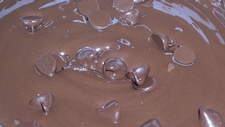Heat and Melting

TEKS Objective
The student will investigate the effects on an object by increasing or decreasing amounts of light, heat, and sound energy such as how the color of an object appears different in dimmer light or how heat melts butter.
Essential Understanding
The student knows that forces cause change and energy exists in many forms.
Science Background
Thermal Energy Physics: ThermalEnergy.org (website) - Explains the physical science of thermal energy and relates it to heat, absolute zero, temperature scale and more.
Thermal Energy Physics
Thermalenergy.org
Energy Story: Energy Quest (website) - Students learn about the energy that makes our world work and about the important role that energy plays in our daily lives.
Energy Story
Energy Quest , California Energy Commission, www.energyquest.ca.gov
Heat Transfer with Coffee: School for Champions (website) - Excellent explanation of heat transfer and insulation, using an everyday item. Questions posed could be used to engage students in discussion of heat transfer.
Heat Transfer with Coffee
School for Champions, www.school-for-champions.com
Melting, Freezing and Boiling Point: Purdue University (website) - Research information on the melting, freezing and boiling points of water and other substances.
Melting, Freezing and Boiling Point
Purdue University, chemed.chem.purdue.edu
Signature Lesson
Water and Ice: Science NetLinks (website) - Students explore what happens to water as it changes from solid to liquid and back again.
Water and Ice
Science NetLinks, www.sciencenetlinks.com
Melting and Freezing: Science NetLinks (website) - Students explore what happens to different substances as they change from a solid to a liquid or a liquid to a solid.
Melting and Freezing
Science NetLinks, www.sciencenetlinks.com
- Supporting Lessons
- Extensions
- Assessment Ideas
- Literature Connections
- Related
TEKS - Additional Resources
Supporting Lessons
The Shape of Kisses: Pennsylvania Department of Education (website) - In this activity, students observe the changes that occur in matter when heat is added or removed.
The Shape of Kisses
Pennsylvania Department of Education, www.pdesas.org
Elaboration Lessons and Extensions
How Does a Thermometer Work? Energy Kids (PDF) - Students build simple thermometers and learn how to use them to measure heat.
How Does a Thermometer Work?
Energy Kids, www.eia.gov
Sun and Shade: Florida Solar Energy Center (PDF) - Students hypothesize how temperatures will differ in sunny and shady locations, and then conduct an investigation to test their hypotheses. Includes teacher background information and student pages.
Assessment Ideas
Create a list of everyday items and ask students to sort them into two groups: objects that melt with the addition of heat and objects that do not melt.
Literature Connections
Energy Heat, Light, and Fuel (Amazing Science). Stille, D. (ISBN-13: 978-1404808409)
Arrow to the Sun: A Pueblo Indian Tale. McDermott, Gerald (ISBN-13: 978-0140502114)
The Sun. Ring, Susan (ISBN-13: 978-0736817141)
Additional Resources
Heat and Temperature: Teach (website) - Interactive activities that enable students to learn about heat and temperature, and the difference between them.
TEKS Navigation
Grade 2
Need Assistance?
If you need help or have a question please use the links below to help resolve your problem.

Comments